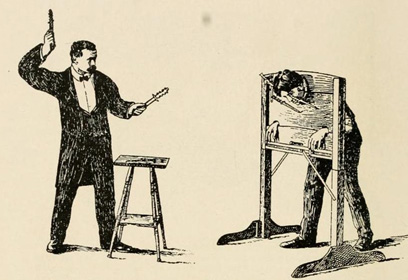So You’ve Been Publicly Shamed
Jon Ronson
Riverhead Books, $27.95 (cloth)
If The Scarlet Letter was the quintessential tale of shame in the Puritan era, then perhaps fiction writer Joshua Cohen’s short story “Emission” can dramatize our current condition.
It follows the downfall of a young man, Mono, who discovers one morning that a shameful secret he confessed to a woman at a party has been reproduced on her blog. Mono is a drifting twenty-something, the son of a Princeton professor who failed to get into the school but still lives in town, selling drugs to undergrads. He has maintained a minimal online presence—“He’d never made a habit of googling himself—it was too depressing a venture”—but when the blog post goes viral, his name suddenly becomes a buzzword, his story a meme. He soon gets turned down by the retail and janitorial jobs he applies to, and fellow dealers refuse to associate with him, since even the cops are “online all the time.” He tries to eradicate the blog post, but it is a futile venture. The blog entry has been reposted and linked so many times, it will undoubtedly follow him for the rest of his life. “The web’s like sweaty footwear,” says a paralegal whose help Mono enlists, “stuff lives in there forever.”
The story appeared in the Paris Review in 2011, a time when its conceit could be dismissed as part of Cohen’s absurd, postmodern project. Reviewing his collection in the New York Times, Rachel Kushner wrote, “The story is clever and occasionally hilarious, even if its premise—that the blog post in question can ruin the life of a guy who deals coke to Princeton undergrads—isn’t quite believable; he’s so marginalized already, there’s little to protect.”
Today such a critique seems naïve: in the full-blown social media age, nobodies have a lot to lose. Jon Ronson demonstrates as much in his new book, So You’ve Been Publicly Shamed, a riveting tour of Web-based flogging. While Ronson chronicles some public figures such as Jonah Lehrer and Mike Daisey, both of whom were shamed for plagiarism, he is most fascinated by cases of ordinary citizens—people whose names were unknown until they made a fatal digital misstep.
One of these is Lindsey Stone, a thirty-year-old nonprofit worker who posted a photo of herself flipping the bird in front of a “Silence and Respect” sign at Arlington National Cemetery. Lindsey and a friend had been taking irreverent pictures throughout their trip to Washington, D.C.—smoking in front of non-smoking signs, mimicking the postures of statues—but once the Arlington photo leaked outside her friend group on Facebook, it created a national uproar. “Lindsey Stone hates the military and hates soldiers who have died in foreign wars,” is one of the tamer responses.
Like the protagonist of Cohen’s fiction, Stone seemingly had little to protect—she worked a fine but unglamorous nonprofit job and still lived with her parents in a small Massachusetts town. Within weeks of her post, though, her transgression was covered by ABC News and the Today Show. A “Fire Lindsey Stone” Facebook page attracted 12,000 likes and eventually succeeded in its goal. When Ronson interviewed her eighteen months after the hoopla, she was struggling with insomnia and depression, afraid to leave her house. “Literally, overnight everything I knew and loved was gone,” she says.
Online shaming is often a cathartic alternative to real efforts at social change.
If social media has a basement—or a dungeon—it is inhabited by the subjects of this book. Ronson takes on the role of a classical hero, descending into the underworld to seek out lost souls. “I’d meet them in restaurants and airport cafés,” he writes, “spectral figures wandering the earth like the living dead in the business wear of their former lives.” Among them is Justine Sacco, a public relations chief who, before boarding a flight for South Africa, tweeted “Going to Africa. Hope I don’t get AIDS. Just Kidding. I’m white!” By the time her plane landed, her post had become the top worldwide trend on Twitter, appended with hashtags such as #racist and #HasJustineLandedYet. Like Stone, Sacco was soon fired from her job. New York Post reporters hounded her for weeks. While Ronson allows that the post was in bad taste and not particularly funny, he notes what is probably obvious to most sober observers: her tweet was a reflexive comment on white privilege. As Sacco tells Ronson, “Living in America puts us in a bit of a bubble when it comes to what is going on in the third world. I was making fun of that bubble.”
Sacco and Stone are far from isolated cases. There was Alicia Ann Lynch, who posted a photo of herself dressed for Halloween as a runner in the Boston Marathon. There was the girl in South Korea who failed to pick up her dog’s feces on the subway. After another passenger photographed her and scored a viral hit with the image, the violator was forever known as Dog Poop Girl. These shamings have become something of an idée fixe in the media, as columnists scramble to diagnose the root causes of the mob mentality. A recent New York Times story faults “The Epidemic of Facelessness,” which attributes the maliciousness of online trolls to the fact they can’t see their victims. Wired’s Laura Hudson calls public shaming “a core competency of the Internet” and argues that shamers vastly underestimate social media’s capacity to ruin lives.
Where the mob seeks to castigate and punish, Ronson wants to call attention to flawed humanity. Where the mob treats offenders as inherently evil, Ronson sees ordinary people making understandable, and forgivable, mistakes. He is baffled at the lack of empathy shown to these individuals, as if they weren’t people but rather “like corporations that had committed PR disasters,” deserving of a boycott.
Ronson implicates himself as well. In 2012 a trio of programmers stole his identity and created a Twitter account that bore his name and his photo but posted nonsensical tweets about guarana and celeriac. Ronson confronted the programmers in a hotel room, taped the exchange on his phone, and then uploaded the video to YouTube, where his outrage was immediately vindicated by dozens of comments calling for the programmers’ demise. “I was Braveheart,” Ronson writes, “striding through a field, at first alone, and then it becomes clear that hundreds are marching behind me.”
Ronson is curious about that thrill, about what drives it, and embarks on a rollicking expedition to find an answer. He goes on tangential journeys into the world of criminal justice, sits in on a “shame eradication” workshop, and visits an extreme porn shoot. He explores the idea of contagion in crowd theory and muses about the illusion of innocence the mob provides: “The snowflake never needs to feel responsible for the avalanche.”
His most interesting observation is that shamers are often convinced they are doing good. The people who took down Sacco believed they were punching up, he argues. “They were cutting down a member of the media elite, continuing the civil rights tradition that started with Rosa Parks, the hitherto silenced underdogs shaming into submission the powerful racist.”
This is just the sort of political gesture Twitter was supposed to enable. In its early days, the service was hailed as a populist tool that would unite and amplify the masses against the interests of the elite. In 2010 Malcolm Gladwell summarized that optimistic perspective. “The traditional relationship between political authority and popular will has been upended,” he wrote, “making it easier for the powerless to collaborate, coördinate, and give voice to their concerns.” While Gladwell was actually skeptical, he was among a cautious minority, at least within the mainstream media. Conventional wisdom held that the people would shame structures of power, be they Wall Street banks or Middle Eastern dictators, into submission. We would capture misdeeds on our camera phones and broadcast them to the world via our personal networks.
Ronson, too, was initially excited by social media’s potential. “I remembered how exciting it felt when hitherto remote evil billionaires like Rupert Murdoch and Donald Trump created their own Twitter accounts,” he writes. “For the first time in history we sort of had direct access to ivory-tower oligarchs like them. We became keenly watchful for transgressions.” But this watchdog instinct turned inward, and social media became cannibalistic, as Ronson documents succinctly in a New York Times adaptation of the Sacco story: “As time passed . . . I watched these shame campaigns multiply, to the point that they targeted not just powerful institutions and public figures but really anyone perceived to have done something offensive.”
Of course, Ronson has chosen his shamees carefully. He focuses on people such as Sacco and Stone, whose sins amount to jokes gone bad, mistaken by the mob as sincere expressions of ideology. One wonders what Ronson would think of the University of Oklahoma fraternity brothers recently caught on video chanting their intention to lynch black people who attempted to join their beloved Sigma Alpha Epsilon. While the incident took place after Ronson’s book was finished, it is the latest in a string of fraternity scandals, including a racist Martin Luther King–themed party at Arizona State University, photos from which were leaked on Instagram last year.
What to make of the shaming that followed these incidents? Some of the SAE fraternity members, now expelled, have received death threats and will undoubtedly face professional ruination far worse than that experienced by Sacco or Stone. But it’s difficult to summon for them the kind of sympathy Ronson reserves for his subjects—mostly because the chant was a product of the racist and violent culture of the fraternity. It wasn’t just one person, and it wasn’t a fluke.
It remains to be seen whether exposés of this sort will lead to enduring change. If the fraternity video does catalyze a larger dialogue about race relations in higher education, it will be largely through the work of local community leaders and student organizations. Unheard—the University of Oklahoma black student alliance that published the video on its YouTube page—is pushing administrators to institute an Office of Diversity and Inclusion and increase scholarship opportunities for black students. Without the sustained action of organizations such as these, the video might have become just another trending blip that dissipated into the ether—though the ruined lives of the shamed few would remain.
If there is a political lesson to take from Ronson’s book, it is that too often the act of shaming is not a launch pad for social change but rather a cathartic alternative to it. When Sacco and Stone were fired from their jobs, the tone of their shamers took on the triumphant tenor of a civil rights victory, as though the world were a step closer to purging its remaining bad apples. But this attitude ignores the systemic nature of oppression; it personalizes social and political ills. In an op-ed on the Sacco incident, Roxane Gay expresses just this concern. “The world is full of unanswered injustice and more often than not we choke on it,” she writes. “When you consider everything we have to fight, it makes sense that so many people rally around something like the hashtag #HasJustineLandedYet. In this one small way, we are, for a moment, less impotent.”
Stone’s case has similar overtones. Ronson doesn’t mention it, but her shaming came at a time when the media was beginning to catch wind of the disability claims backlog at the Department of Veterans Affairs. Reports revealed that veterans were waiting for years to be seen by VA doctors. It was a scandal mired in Kafkaesque absurdity, a messy collision of bureaucratic incompetence and political corruption. Whenever Jon Stewart brought up the story on The Daily Show, his face would contort into the visage of exasperated disbelief he adopts when covering wrongdoings that lack an identifiable culprit. To the many citizens who were incensed by these reports, Stone’s photo was a concise expression of a much larger evil: a symbol of national disregard for military service and its attendant wounds. And attacking her had tangible, immediate results.
Later, the public found a more suitable enemy in Eric Shinseki, the VA secretary, who was made the villain of what was in reality a larger and more entrenched culture of corruption. When veterans groups finally succeeded in pressuring him to resign, the public gaze, satisfied by this sacrifice, turned elsewhere while the long wait times persisted. Almost a year after Shinseki fell on his sword, one of the original whistleblowers, former VA doctor Sam Foote, concluded, “Very little has changed.”
The VA imbroglio, like so many public scandals, underscores the hazard of mistaking symbol for structure. The ritual takedown of a scapegoat may gratify, however fleetingly, an impulse for justice, but it often benefits the very institution supposedly under attack. We perpetuate the system when we limit our outrage to a single person. That is not to say systemic problems are immune to public activism, but even minor change requires persistent and sometimes tedious work.
The powers that be may actually benefit from online shaming. Ronson pulls back the curtain on the mechanics of the shaming process and discovers that Google makes thirty-eight cents in advertising revenue for every search query that takes place on its site. With the help of an economist, Ronson comes up with a rough calculation of what Google made from the Sacco scandal: $120,000. The people who shamed her, of course, received nothing. Ronson quotes reputation-management consultant Michael Fertik, “The biggest lie . . . is, The Internet is about you,” Fertik says. “It’s about the companies that dominate the data flows of the Internet.”
Fertik runs Reputation.com, one of the companies that have sprung up to help people recover from shaming incidents. In one of the book’s more captivating moments, Ronson convinces Fertik to take on Stone’s case, expunging her photo from the Internet—or at least moving it down a few pages on the search results. Fertik admits that a case such as hers would ordinarily cost hundreds of thousands of dollars—many of his clients are CEOs and celebrities—but he agrees to take Stone’s case pro-bono, so that Ronson can observe the process.
Stone is assigned her own Reputation.com consultant, Farukh Rashid, who strategically floods Google with positive posts attached to her name. “His plan was to create Lindsey Stone Tumblrs and LinkedIn pages and WordPress blogs and Instagram accounts and YouTube accounts to overwhelm that terrible photograph, wash it away in a tidal wave of positivity,” Ronson writes. Stone is somewhat bewildered by the whole process. “As a normal person I don’t really know how to . . . brand myself online,” she admits. But she gamely plays along, giving Fertik information about her private life while Ronson eavesdrops on their conversation via a party line:
Her favorite TV show was Parks and Recreation. Her employment history included five years at Walmart, ‘which was kind of soul-suckingly awful.’
‘Are you sure you want to say that Walmart was soul-sucking?’ Farukh said.
‘Oh . . . What? Really?’ Lindsey laughed as if to say, ‘Come on! Everyone knows that about Walmart!’ But then she hesitated.
After a series of these interviews, Rashid writes blog posts “in her voice.” The new Stone gushes about the latest Lady Gaga album and pays tribute to Disneyland: “Happy Birthday, Disneyland! The Happiest Place on Earth!” The real Stone cringes at this. It doesn’t sound like something she would say. Ronson concludes that the enemy is homogenization: “We were creating a world where the smartest way to survive is to be bland.” As the book draws to a close, he quotes the filmmaker Adam Curtis, who argues that social media has become “a giant echo chamber where what we believe is constantly reinforced by people who believe the same thing.”
It may be true that social media is an echo chamber, but it is not only one another we’re parroting. There are also the corporate interests who have sizable financial claims on these sites. We end up taking cues from corporations, whose well-paid PR teams scrub and sanitize every post. Ordinary humans—those who cannot afford Reputation.com—try desperately to follow their lead, echoing the familiar marketing cadences, a tonal imitation that is most obvious in the wake of a national tragedy, when the flood of tweets and status updates begins to sound less like an outpouring of legitimate grief than a collection of official releases cooked up in marketing labs, a dispatch from the personal brand.
Perhaps this explains why it has become so easy to mistake people for “corporations that had committed PR disasters”: we have learned to speak the consensus-seeking language of business. There is a telling moment in the opening chapter of the book, when Ronson confronts the programmers who stole his identity. One of the programmers, Dan, defends himself by dismissing Ronson’s online persona as nothing more than a marketing fabrication used to promote his personal brand. Ronson finds this deeply offensive. “I told Dan that I had never used the term brand management in my life. ‘Language like that is alien to me,’” Ronson protests.
Dan doesn’t buy it. “We think there’s already a layer of artifice and it’s your online personality—the Brand Jon Ronson—you’re trying to protect.” This presumption finally drives Ronson into a rage. “NO, IT’S JUST ME TWEETING,” he shouts at the three men.
Ronson doesn’t dwell on this moment, but something about his response stayed with me long after I’d finished the book: the necessity of all-caps, the wild and exasperated assertion of his personhood, as though he needed to remind himself. Perhaps the reminder is useful these days, when the Supreme Court aggressively asserts corporate personhood and individuals must carefully curate their personal brands. Inversions such as these can obscure guilty parties and make us forget who—or what—we truly wish to shame. And in such a climate, we all have something to lose.








